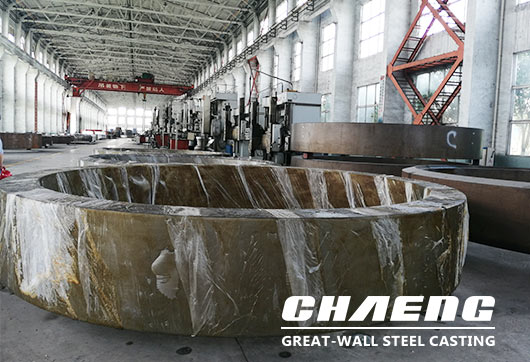Solutions to rotary kiln tyre failure
05 Aug 2022 UTC+8Views:

The kiln tyre assembly is an important part of the rotary kiln. During the operation of the rotary kiln, contact with the supporting roller plays a role in supporting the weight of the kiln body. Its load is heavy, the torque is large, there are multiple fulcrums, and the operating system is complicated. Whether the fault of the rotary kiln tyres can be repaired quickly is very important. In the following, The rotary kiln tyre manufacturer Great Wall Casting (CHAENG) will share some solution methods to the fault of the rotary kiln tyres.
The kiln tyre assembly is composed of a cylinder section, backing plates, a retaining ring section, stoppers and a tyre. In actual operation, the common faults of the tyre assembly include the shedding of the tyre surface, the axial movement, the loosening and falling off of the retaining ring, the welding off of the block, the breakage of the backing plate bolt, etc., and even the crack of the tire and the deformation of the cylinder. Such phenomena have seriously affected the stable operation of the clinker kiln, disrupted the normal production order, reduced the operation cycle, and increased maintenance time and costs.
In the event of a failure of the kiln tyre, the first emergency stop should be made, the oil pressure of the middle thrust roller should be disconnected, and the axial rise and fall should be controlled by the tail thrust roller.
Following the instructions below can also reasonably reduce the failure between the kiln tyre and the thrust roller, which is a good way to reduce the equipment failure rate.
1. Inject grease into the bearing surface of the third gear supporting roller to force the kiln body to descend axially until the horseshoe between the guide rods on both sides of the rear gear roller is fully compressed.
2. Unload the oil pressure in the oil cylinder of the rear thrust roller.
3. It takes 1.5min to rotate the rotary kiln at a slow speed.
4. Push the kiln body to its axial upward position through the hydraulic device of the rear thrust roller, so that the middle kiln tyre and the middle thrust roller are out of contact, and the gap between the two can be maintained at a distance of 20mm.
5. Tighten the horseshoe pads between the guide rods on both sides of the rear thrust roller.
CHAENG recommends users reasonably control the axial rise and fall of the rotary kiln when using the rotary kiln so that it can drive the pinion gear and the girth gear on the cylinder to achieve uniform wear and prolong its service life.





